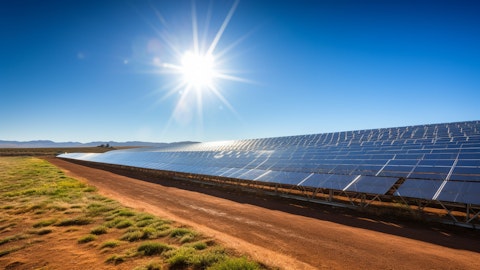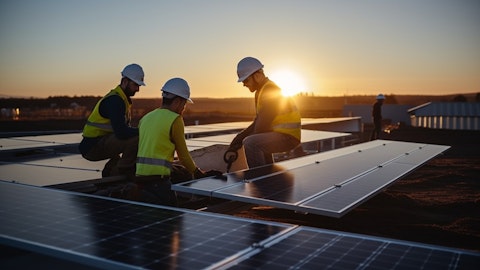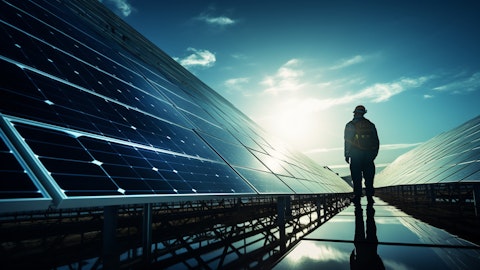Philip Shen: Got it. Okay. So it’s only 2 gigawatts of module. Well, it is 2 gigawatts of module. The way it was written on the slide, Slide 6, it sounded like 2 gigawatts of integrated capacity could be in the US. But my follow-up here, and then I’ll wind it down, is, what is, and this might be a bit of a tough question, but what is your view of the discussion around the foreign entity of concern language, which a lot of people are talking about could be added to the 45X manufacturing PTC, which might make it more difficult for you guys to add or to receive the PTC. You’re ramping up your facility basically now, if not maybe in a month in April. To what degree does that concern you? Are you following that topic at all? Thank you.
Charlie Cao: I’m not, first of all, I’m not familiar with the topics you are talking about. The [indiscernible] regulations updates, but we will follow up after the call. But I think, I’m not sure you’re talking about, like the semiconductor, the sensitive technology, but we think solar is more pervasive and very common for each country to develop and it’s not data sensitive. But anyway, we will follow up on the topic you are talking about, but not for many reasons, the progress.
Philip Shen: Okay. Thank you, Charlie. I know I asked a lot of questions. Appreciate it. We’ll pass it on.
Charlie Cao: Thanks.
Operator: Thank you. Your next question comes from Alan Lau with Jefferies. Please go ahead.
Alan Lau: Thank you for taking my question. So I would like to know, because there is a very detailed capacity expansion plan, and I just would like to ask a bit on the details. So by the end of 2024, it would be 120, and then 110, and 130 gigawatts for wafer cell modules. So my question is mainly on the cell. Because the company has 70 gigawatts of TOPCon by the end of 2023 and supposedly the remaining 20 gigawatts is PERC, so — and then by the end of this year it’s 110. So, will it be 100 gigawatts of TOPCon plus 10 gigawatts of PERC? If that is the case, then do you mean you would impair the 10 gigawatts of PERC this year?
Gener Miao: The answer is we will phase out the 20 gigawatts of PERC capacity throughout the year. That’s the plan. And we have one — everything we have discussed by the end of the year, the capacity is 100% N-type. It’s not — no P-type capacity. The sale capacity is 110 and the major part is the 28 gigawatts, the Shanxi, [super factories] (ph) plus what we are talking about the Vietnam 4 gigawatts. As well as we have some improvement of production, the volume, existing capacity. So total is 110 for the entire TOP capacity. We did have 28 gigawatts PERC capacity and we don’t have time to upgrade and we think it’s not economic, it makes sense. And the most important thing is we have depreciated the capacity over five years. So we don’t believe we have significant burden for the 20 gigawatts, the PERC. And we focus on the new technology and new PERC. That is, I think that is the smart decision.
Alan Lau: Actually — so just to confirm, basically for the 20 gigawatt of PERC, they are fully depreciated. So basically they were built in 2019 and then by now they are fully depreciated. So you do not see major impairment risk this year, right?
Gener Miao: Yes, roughly, yes. And we did have some kind of residual value but it’s not significant. Most of the assets have been depreciated.
Alan Lau: Yes, I think that’s impressive because a lot of peers in this industry might have a lot of impairment this year. So my next question is what is the new signed ASP for the contract that you are signing in the US market because I have been hearing different feedback saying that prices for utility projects in the US are declining from $0.30 to below $0.30 since 4Q. So I’d like to learn your view on this front.
Gener Miao: Yeah, there’s a [indiscernible] index and for the US, the price range is a little bit, I think a little bit big, high 20, low 30, that kind of the range. And it looks like it’s in the downward trend, but relatively stable. And the different customers, different preference. And we think we are in good position because we have traceability and we have separate poly and wafer through the modules. And we think we can still relatively know the price premium with our peers.
Alan Lau: Thanks. So you have mentioned overseas polysilicon. So we would like to have an update on the overseas polysilicon price. Is it rebounding or is it still trending down?
Gener Miao: I think in recent three months, it’s relatively stable because the polysilicon out of China is around 100,000 metric tons. It’s known new capacity are expected in the next 1.5 year. The other thing is maybe some China party — but I think there is a relatively risk, and there’s a very complicated compliance. So we don’t see significant downward and relatively stable.
Alan Lau: I see. So switching gear to the European market, because you have mentioned destocking has basically completed. So we would like to follow up on this. Are you receiving orders in a normalized manner? Like, how about — is it from the residential market or it’s maybe from the utilities market in Europe?
Gener Miao: I think both. In the recent quarter, I think the majority is the DG and the market. But we see both, utility and the DG will grow year-over-year.
Alan Lau: So you don’t see inventory as an issue even in the DG market anymore because last year it was a huge issue.





